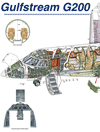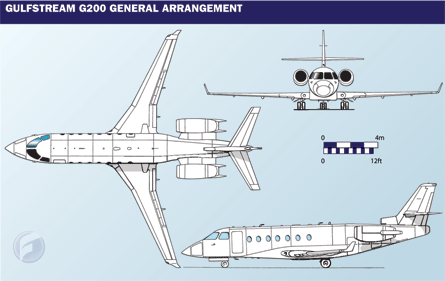Gulfstream's G200 has matured along with the market it created - the super mid-size business jet. As the Israel Aircraft Industries Galaxy, the aircraft was the first to bring large-cabin comfort to the mid-range market and as the sector has grown so has the G200's standing within the Gulfstream family.
When Gulfstream acquired the Galaxy in 2001 it was less than perfect - performance, quality and reliability were not up to the iconic brand's standards. Six years and substantial investments later, Gulfstream is certain the G200 is a suitable stablemate for its market-leading G450 and G550 large-cabin jets. New customers will have to wait 17 months for the $22.1 million aircraft.'10478'
"We have done a lot of work with the G200 to make it one of the Gulfstream family," says Stan Dixon, director, mid-cabin products. Interior improvements have reduced weight, increased payload and range, reduced noise levels and improved quality and reliability. "Fit and finish is on a par with the G450 and G550," Dixon says.
"There have been a number of programmes to improve the reliability and availability of the aircraft," says Paul Woodcock, manager, G200 entry into service. Packaging service bulletins into a series of short-term enhancement programmes (STEP) "has been very successful in developing the reliability of the product", he says.
WIDE CABIN
Improvements in completion quality and dispatch reliability have allowed Gulfstream to capitalise on the G200's strengths - a cabin cross-section comparable to the G450/G550 in an aircraft with a small ramp presence, intercontinental range and low operating costs. As a result, says Dixon, more of Gulfstream's traditional large-cabin customers are adding the super mid-size G200 to their fleets.
Development of the IAI-1126 Astra Galaxy was launched by Israel Aircraft Industries in September 1993. The aircraft combined the high-speed wing from IAI's Astra mid-size jet with an all-new widebody fuselage providing a stand-up cabin, and was aimed at filling the gap between mid-size and large-cabin jets. Pratt & Whitney Canada PW306A engines and Rockwell Collins Pro Line 4 avionics were selected.

First flight of the Astra Galaxy was in December 1997, leading to Israeli and US certification a year later, and the first customer aircraft was delivered in January 2000. By then, marketing and support had become the responsibility of US company Galaxy Aerospace, which was formed in February 1997 by IAI and the Pritzker family, owners of the Hyatt hotel chain. Completion and deliveries were performed at Galaxy's facility at Alliance airport in Fort Worth, Texas.
Gulfstream acquired Galaxy Aerospace in June 2001, and subsequently renamed the Astra the G100 and the Galaxy the G200 as part of a wider rebranding. At the same time, leading fractional-ownership operator NetJets announced 50 orders and 50 options for the aircraft, citing the service and support provided by Gulfstream as a factor in its decision. By August 2007, NetJets had 27 aircraft.
IAI continues to build the green aircraft in Tel Aviv. They are flown to Gulfstream's Dallas Love Field completion centre following closure of the former Galaxy facility at Alliance in 2002. Built in-house, Gulfstream interiors were installed beginning with aircraft number 70, replacing the Nordam-supplied prefabricated kits previously fitted by Galaxy.
Redesign of the interior reduced basic operating weight by 295kg (650lb), improving the G200's payload and range. "We invested a lot to take weight out and make sure aircraft had good range," says Dixon. "Range is now 3,400nm [6,300km] with four passengers. It's a good US coast-to-coast transcontinental aircraft all of the time."
FIT AND FINISH
Gulfstream's completion improvements also reduced cabin and cockpit noise levels by 3-5dB as well as improving interior fit and finish. "Materials and quality are to the same standards as in the G550," Dixon says. Completion times were also reduced, typically to less than four months.
A range of interior layouts are available, but the majority of aircraft are completed with one of two floor plans - nine-passenger, with six individual seats and a three-place divan and 10-passenger, with four individual seats, two-place divan and four-place conference group.
Dixon says the standard G200 is well-equipped and options are "fairly minimal". Autothrottle was introduced as an option in 2004, and is specified by a high percentage of customers, he says. High-speed data was introduced in 2005, but Gulfstream will not be drawn on other upgrades that might be in the pipeline - including the possibility of offering the enhanced vision system pioneered on its large-cabin aircraft. "We are always looking for opportunities to improve the product line, and the G200 is not exempt," he says.
The company's near-term focus has been on bringing the aircraft's dispatch reliability up to Gulfstream standards, and it is mid-way through fielding its fourth package of improvements. STEP 4 is a package of 14 recommended service bulletins, and the company has set the target of upgrading the fleet within a year, by March 2008.
"NBAA dispatch reliability at the end of July was 99.81%, which is on a par with our large-cabin aircraft," says Woodcock. "We did a great deal between 2004 and 2007 and we're seeing a steady month-on-month rise in the 12-month rolling average." Dispatch reliability was 99.2% when Gulfstream launched STEP 2 in August 2004, and had reached 99.75% before STEP 4 was introduced.
Woodcock says the reliability improvement is across the fleet, which stood at 154 aircraft by the end of June, including the 36 built before Gulfstream acquired Galaxy and those with the original interior. "We have worked hard to ensure the improvements are applicable across the entire serial-number range."
Although the upgrades are voluntary, Gulfstream offers operators incentives to incorporate the packaged improvements. "If the aircraft is in warranty, the work is free. Out of warranty, the parts are free," says Woodcock. STEP 4 may be the last of the improvement packages. "It may be as far as we need to go, but we are not resting on our laurels and will continue to improve aircraft," he says.
An MSG-3 maintenance programme was developed and introduced last year to reduce scheduled operating costs and improve aircraft availability, and Woodcock says about 59% of the fleet has transferred since August 2006. The move from calendar-based to task-based maintenance extends the A-check interval from 300h to 500h. The payoff for Gulfstream of these efforts to improve dispatch reliability and reduce operating costs is that "product support and service sells aircraft", says Dixon, adding: "Service and support is a differentiator." This becomes important as operators look to move up from the G100/G150/G200 to company's large-cabin aircraft.
Gulfstream does not split out its mid-size and super mid-size sales, but the 42 G150/G200s delivered in 2006 accounted for almost 40% of its total aircraft shipments and first-half deliveries were up year-on-year. "The G200 is a successful piece of our business in terms of numbers of aircraft," says Dixon.
"Super mid-size is very diverse market, which is exciting for us. There is no one predominant customer segment - individuals and small, medium and large companies in all industries," he says. Gulfstream is seeing new customers come to the G150/G200 then move up - "and the opposite, [large-cabin operators] adding the G200 for shorter trips", says Woodcock, who adds: "We also seeing recently a lot of international interest, particularly in Europe and Far East."
Source: Flight International























